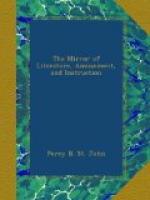been unequalled in the works of man. A mass of
granite, of a size at present most immense, but formerly
most astonishing, is the pedestal. A steep acclivity,
like that of a rugged mountain, carries the eye to
its summit, which looks down on the opposite side
to a descent nearly perpendicular. The figure
of the hero is on horseback, supposed to have attained
the object of his ambition, by surmounting all the
apparent impossibilities which so arduous an enterprise
presented. The victorious animal is proudly rearing
on the highest point of the rock, whilst his imperial
master stretches forth his mighty arm, as the father
and protector of his country. A serpent, in attempting
to impede his course, is trampled on by the feet of
the horse, and writhing in all the agonies of expiring
nature. The Emperor is seated on the skin of
a bear; and habited in a tunic, or sort of toga which
forms the drapery behind. His left hand guides
the reins; his right is advanced straight forward
on the same side of the horse’s neck. The
head of the statue is crowned with a laurel wreath.”
It was formed from a bust of Peter, modelled by a
young French damsel. The contour of the face
expresses the most powerful command, and exalted, boundless,
expansion of thought. “The horse, says
Sir Robert, is not to be surpassed. To all the
beauties of the ancient form, it unites the easy grace
of nature with a fire which pervades every line; and
gives such a life to the statue, that as you gaze
you expect to see it leap from the pinnacle into the
air. The difficulty of keeping so great a mass
of weighty metal in so volant an attitude, has been
admirably overcome by the artist. The sweep of
the tail, with the hinder parts of the horse, are
interwoven with the curvatures of the expiring snake;
and together compose a sufficient counterpoise to
the figure and forepart of the animal."[6]
[6] Travelling Sketches in
Russia and Sweden. By Sir Robert Ker
Porter,
4to.
Our representation of this masterpiece of art is copied
from a Russian medallion presented to our ingenious
artist, Mr. W.H. Brooke, by M. Francia.
* * * *
*
SPIRIT OF THE PUBLIC JOURNALS.
* * * *
*
FAMILY POETRY.
—Modo sumpta veste virili!—HOR.
Zooks! I must woo the Muse to-day,
Though line before I’d
never wrote!
“On what occasion?” do you
say?
OUR DICK HAS GOT A LONG-TAIL’D
COAT!
Not a coatee, which soldiers wear
Button’d up high about
the throat,
But easy, flowing, debonair—
In short a civil long-tail’d
Coat.
A smarter you’ll not find in town
Cut by Nugee, that Snip of
note;
A very quiet olive-brown
’s the colour of Dick’s
long-tail’d Coat.
Gay jackets clothe the stately Pole,
The proud Hungarian, and the
Croat,
Yet Esterhazy, on the whole,
Looks best when in a long-tail’d
Coat.




